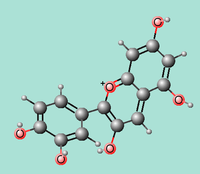
Back أنثوسيانيدين Arabic Antocianidina Catalan Anthocyanidine German Antocianidino EO Antosyanidiinit Finnish Anthocyanidine French Antocianidina GL Antocianidina Italian アントシアニジン Japanese 안토시아니딘 Korean

Anthocyanidins are common plant pigments, the aglycones of anthocyanins. They are based on the flavylium cation,[1] an oxonium ion, with various groups substituted for its hydrogen atoms. They generally change color from red through purple, blue, and bluish green as a function of pH.
Anthocyanidins are an important subclass of the polymethine dyes and flavonoids. The flavylium cation is a chromenylium cation with a phenyl group substituted in position 2; and chromenylium (also called benzopyrylium) is a bicyclic version of pyrylium. The positive charge can move around the molecule.
At least 31 monomeric anthocyanidins have been properly identified in living organisms, mostly as the core components of anthocyanins. The latter are responsible for the red, purple, blue, or black color of many fruits (like grapes and blueberries), flowers (like roses), leaves (like purple cabbage), and even tubers (like radishes and purple yams). They are also found in some animals.[citation needed]